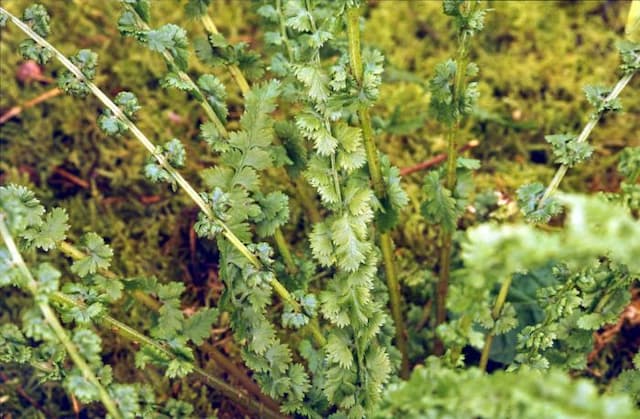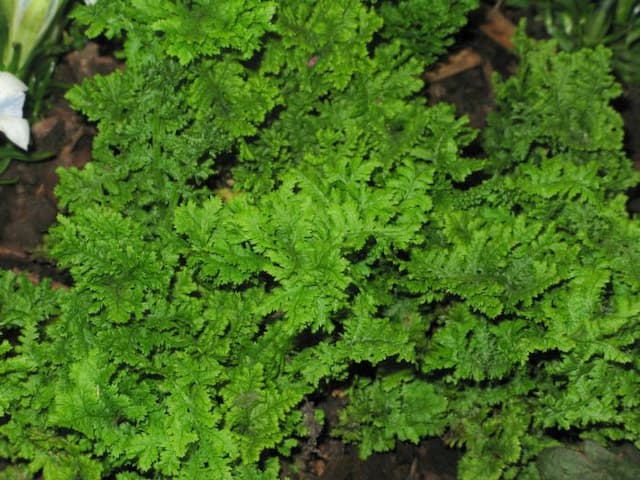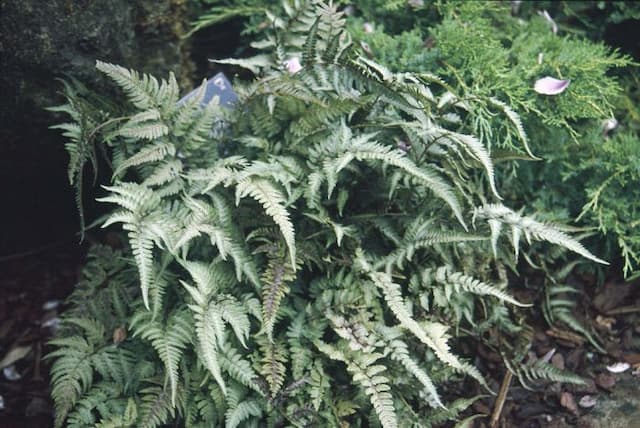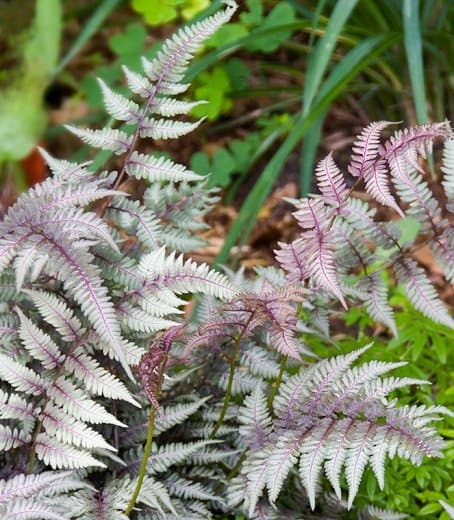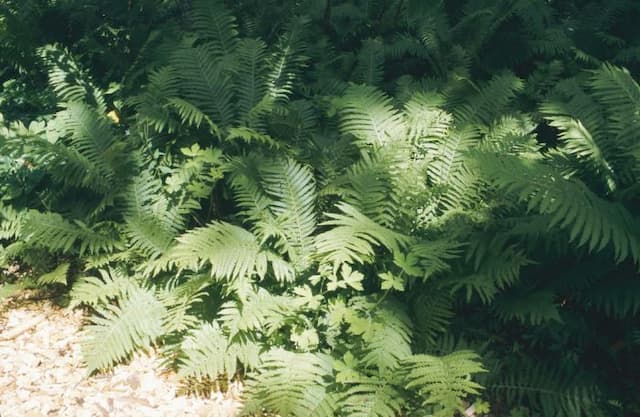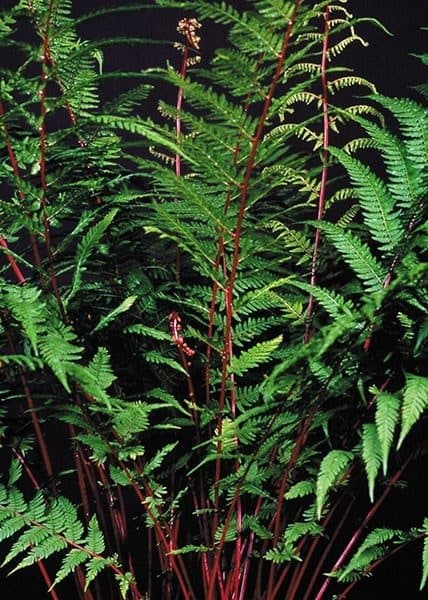Oak Fern Gymnocarpium dryopteris 'Plumosum'

ABOUT
Gymnocarpium dryopteris 'Plumosum', commonly known as the fern Oak Fern, has a delicate and lace-like appearance that provides a soft texture to the spaces it adorns. The Oak Fern typically displays a bright to medium green color that can add a lively touch of greenery to any garden. The fronds of the Oak Fern are compound, meaning they are divided into smaller leaflets, with each leaflet being further divided into sub-leaflets, resulting in a feathery look which gives the plant its light and airy feel. The overall shape of the Oak Fern fronds is triangular, and they are generally arranged in a symmetrical and orderly fashion. The central stem, which is referred to as a stipe in fern terminology, is slender and may be a lighter color compared to the leafy parts, sometimes taking on a green to straw hue. The leaflets themselves are held aloft by thin, wiry stems that branch off the main stipe. Oak Fern thrives in shady conditions and hence, its foliage maintains a fresh, vibrant appearance even without direct sunlight, a quality that makes it highly sought after for shaded gardens or indoor environments with filtered light. Its fronds, with their intricate divisions and subdivisions, create a complex visual texture that is both soothing and visually engaging. It's worth noting that the plant has a charming presence without dominating the space with its size.
About this plant
 Names
NamesFamily
Cystopteridaceae.
Synonyms
Western Oakfern, Northern Oak Fern, Oak Fern.
Common names
Gymnocarpium dryopteris, Dryopteris linnaeana, Phegopteris dryopteris, Polypodium dryopteris, Thelypteris dryopteris, Aspidium dryopteris.
 Toxicity
ToxicityTo humans
Gymnocarpium dryopteris, commonly known as the northern oak fern, is not known to be toxic to humans. There are no well-documented cases or reports of poisoning from ingesting any part of this plant, and it is not listed as a toxic entity by major health organizations. However, it is generally advisable not to consume plants that are not known to be edible, as individual reactions to non-toxic plants can vary.
To pets
The northern oak fern is not known to be toxic to pets. There are no typical symptoms of poisoning associated with this plant, as it is not listed as a poisonous plant to pets by major veterinary organizations. While the lack of reported toxicity suggests that it is generally safe, it is always wise to prevent pets from ingesting plants that are not specifically intended for their consumption, as they could have individual sensitivities or allergic reactions.
 Characteristics
CharacteristicsLife cycle
Perennials
Foliage type
Deciduous
Color of leaves
Green
Height
1-2 feet (30-60 cm)
Spread
1-1.5 feet (30-45 cm)
Plant type
Herb
Hardiness zones
3-8
Native area
Northern Hemisphere
Benefits
 General Benefits
General Benefits- Easy to care for – Gymnocarpium dryopteris 'Plumosum', or Oak Fern, is low-maintenance and great for gardeners of all skill levels.
- Shade tolerant – Oak Fern thrives in shady areas where other plants may struggle, making it ideal for woodland gardens.
- Ground cover – It spreads easily and can cover ground effectively, helping to suppress weeds.
- Attracts wildlife – Oak Fern can attract beneficial insects and provide habitat for native fauna.
- Aesthetic appeal – Its delicate, feathery fronds add texture and grace to shaded garden areas or rockeries.
- Drought resistant – Once established, this fern can tolerate periods of dryness, reducing the need for frequent watering.
- Non-invasive – Unlike some other ferns, Oak Fern is not aggressive and won't overtake gardens or natural areas.
- Frost hardy – Oak Fern can survive in cooler climates and withstand frost, making it a versatile choice for many locations.
 Medical Properties
Medical PropertiesThis plant is not used for medical purposes.
 Air-purifying Qualities
Air-purifying QualitiesThis plant is not specifically known for air purifying qualities.
 Other Uses
Other Uses- Garden pathways: Oak fern can be planted along garden pathways to create a soft, airy groundcover that adds a natural look to garden walkways.
- Diorama and model making: The fine texture and delicate appearance of oak fern fronds can be used in crafting realistic miniature landscapes for model train sets or dioramas.
- Fairy gardens: Due to its small size and enchanting look, oak fern is ideal for creating fairy gardens, providing a lush backdrop for miniature fairy structures and figures.
- Flower arrangements: The fronds of oak fern can be used as greenery in floral arrangements to provide contrast and a feathery texture.
- Shade groundcover: This plant is suitable for shaded areas where grass might struggle to grow, helping to prevent soil erosion and maintain moisture levels in the ground.
- Photography: Its intricate fronds can serve as a beautiful, natural subject or backdrop for botanical photography.
- Art inspiration: Oak fern's delicate structure and elegant form can provide inspiration for artists and be featured in botanical drawings or paintings.
- Containers and hanging baskets: Oak fern can be planted in containers or hanging baskets to add greenery to balconies, patios, or indoor spaces with enough light.
- Theme gardens: This plant can be used in specific garden themes such as prehistoric or dinosaur gardens, adding to the lush, ancient ambiance.
- Culinary decoration: While not an edible plant, oak fern fronds can be used to decorate platters or serving trays with food, as long as they do not come into direct contact with the edible items.
Interesting Facts
 Feng Shui
Feng ShuiThe Oak Fern is not used in Feng Shui practice.
 Zodiac Sign Compitability
Zodiac Sign CompitabilityThe Oak Fern is not used in astrology practice.
 Plant Symbolism
Plant Symbolism- Resilience: Often found in a variety of harsh environments, the Northern Oak Fern symbolizes the ability to thrive under difficult conditions.
- Subtlety: With its delicate fronds, the Northern Oak Fern represents a quiet grace and the strength in gentleness.
- New Beginnings: The fern's growth pattern from fiddleheads suggests renewal and the start of a new chapter.
- Endurance: The Northern Oak Fern is known for its staying power through the changing seasons, mirroring the human trait of endurance.
- Solitude: Often found growing alone, it embodies the value of solitude and the importance of reflecting in quiet spaces.
 Water
WaterFor the Northern Oak Fern, it's crucial to maintain even soil moisture without overwatering. It prefers a consistently damp environment so it's recommended to water this fern once a week, providing about 1/4 gallon of water for a medium-size pot each time. The frequency of watering may increase during the warm months or if the indoor air is particularly dry, and lessen during the cooler months. It's important not to let the soil become soggy or waterlogged, as this can lead to root rot. Ensure the pot has adequate drainage and check the soil's moisture level before watering to avoid overhydration.
 Light
LightThe Northern Oak Fern thrives best in bright, indirect light, making it an ideal choice for a spot near a north-facing or east-facing window where direct sunlight is limited. Avoid placing it in full sun, which can scorch its delicate fronds. This fern will also do well under the diffused light of a shaded garden if grown outdoors, as long as it's protected from strong midday sun.
 Temperature
TemperatureNorthern Oak Fern grows optimally in temperatures ranging from 60°F to 75°F, and should be protected from drastic temperature changes. It can tolerate a minimum temperature of about 50°F, but prolonged exposure to cold can be detrimental. Keep it away from drafty windows and doors during the winter months to avoid exposure to freezing temperatures.
 Pruning
PruningPruning the Northern Oak Fern is typically done to remove any brown or damaged fronds, which helps maintain the plant's aesthetic and supports healthy growth. It's best to prune in the spring or after the fern has completed a growth cycle. Snip the unwanted fronds at the base, taking care not to damage the rhizome. Regularly inspecting and tidying the plant can be done throughout the year as needed, but major pruning should be reserved for the prime growth period.
 Cleaning
CleaningAs needed
 Soil
SoilThe Oak Fern requires a well-draining soil mix with high organic matter, such as a combination of peat moss, perlite, and loam. The soil pH should be slightly acidic to neutral, ranging from about 5.5 to 7.0 to ensure optimal growth.
 Repotting
RepottingOak Ferns should be repotted every 2 to 3 years to refresh the soil and provide room for growth. It is best to repot in the spring when the plant is emerging from dormancy.
 Humidity & Misting
Humidity & MistingOak Fern thrives in high humidity conditions, with ideal levels ranging from 60% to 80%. Maintaining high humidity is crucial for the health of this plant.
 Suitable locations
Suitable locationsIndoor
Provide shade, moist soil, and high humidity.
Outdoor
Plant in shaded, moist areas with good drainage.
Hardiness zone
3-8 USDA
 Life cycle
Life cycleGymnocarpium dryopteris 'Plumosum', commonly known as the Oak Fern, begins its life cycle as a spore released from the underside of mature fronds. These spores germinate in moist, shaded soil to produce a prothallus, the gametophyte stage, which is a small, heart-shaped green structure that houses both male and female reproductive organs. After fertilization occurs in the presence of water, the zygote develops into a new sporophyte, establishing a tiny fern plant. The young sporophyte goes through a juvenile phase as it produces its first true leaves, or fronds, and establishes itself. As it matures, the plant enlarges and reproduces through the production of new spores on the undersides of its fronds. Eventually, the mature Oak Fern can spread vegetatively by rhizomes and can form extensive colonies, completing its life cycle when it dies and decomposes, enriching the forest floor for the next generation.
 Propogation
PropogationPropogation time
Spring to early summer
The Northern Oak Fern, Gymnocarpium dryopteris 'Plumosum', is commonly propagated by spores. This method, highly popular for ferns, involves collecting the spores when the sporangia, typically found on the undersides of the fronds, have turned brown and are ripe. This usually occurs in summer, which is the best season to gather spores for propagation purposes. The spores are then sown on the surface of a sterilized, moistened mix of peat and sand in a container, which should be kept in a warm, shaded place, ensuring high humidity. Notably, patience is required, as it can take several weeks or even months for the spores to germinate and develop into the prothallus stage, which is the precursor to the mature fern.
